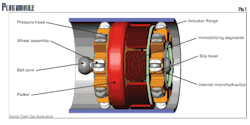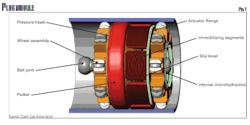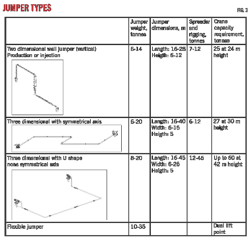Jaime Farinas
Gary Nunez
Transierra SA
Santa Cruz de la Sierra, Bolivia
A combination of simple ideas and application of standards from outside the oil and gas industry allowed fabrication and installation of structures robust enough to defend natural gas pipeline valves, but flexible enough to still allow for easy maintenance.
In September 2008, an attack occurred on Bolivian Transierra SA's 432-km, 32-in. OD Yacuiba-Rio Grande (GASYRG) natural gas pipeline, damaging the pipeline and causing a fire in safety block valve SDV-03. The attack led to both environmental harm and reduced transportation capacity.
With civil unrest causing blocked roads, closed airports, and a lack of spare parts, fuel, and equipment, Transierra still repaired the pipeline in 60 hr. It became clear, however, that sensitive points in the pipeline remained highly vulnerable to third-party actions.
As part of its longer-term response to these events, Transierra developed and implemented a pipeline and facilities integrity management program for GASYRG, which runs from southern Bolivia to the Rio Grande compression station in Santa Cruz and is part of the gas export system to Brazil.
Essentials of this program included:
- Data management.
- Materials, design data.
- Data integration.
- GASYRG performance data.
- Change management.
- Operating procedures.
- Mitigation, repair.
- Risk assessment.
The program established a base line risk analysis with criteria established in ASME B 31.8S regarding threat categorization (time-dependent, time independent, and stable). Third-party actions, however, fell below the critical-alert level in the resulting risk matrix.
New scenarios
The social unrest prompted Transierra to examine various alternatives for improving protection of its installations and guaranteeing operational continuity, despite third-party damage having been classified by the threat matrix as only a moderate risk. Transierra's resulting contingency plan rested on three fundamental elements:
- Physical security for the facilities.
- Mitigation of further incidents.
- Timely reaction to events.
Engineering development followed these guidelines:
- Robustness, security against malicious acts of third parties.
- Functionality, aesthetic integration.
- Operational and maintenance ease.
- Concealed access.
Engineering concept
These criteria guided systematic development of detailed engineering for mechanical protection of 11 GASYRG safety valves. Operations, maintenance, and security personnel all contributed to the process of protecting the valves without disrupting inspection and maintenance routines. The resulting model consisted of a sliding box sectioned in half, with the two halves separating at the center and sliding in opposite directions to allow access (Figs. 1-2).
The structure consists of a metal skeleton made of square tubes, 0.25-in. thick metal plates, eight fixed wheels on each half of the box, and two metal 6-in. by 15-ft W-type rails (Figs. 3-4). The metal skeleton inside the box prevents metal plate deformation and adds rigidity to the assembly (Fig. 5).
Engineering design applied international standards for bulletproof armor to the metal structure protecting the valves. Standards used included EN 1063 (European Community Ballistic Standard), UL 752 (Underwriters Laboratories Ballistic Standard), NIJ 108 (US National Institute of Justice Standard) and NOM 142 (Mexican Standard) and specified steel plate thickness of 0.125-0.500 in.
This structure's functional criteria led to selection of 0.25-in. thick steel, providing ASTM A-36 Level IV protection able to withstand assault with intermediate level weapons (.38, .44, and 9-mm pistols and assault rifles).
Foundation design accounted for the need to support the entire protection structure and also act as an additional enclosure on the lower perimeter of the containers. Design adopted a maximum weight (dead and overload) of 2,300 kg distributed among four foundations and the perimeter cord on which the sliding metal box lies. When the metal box is closed it rests directly on the perimeter cord; when it is open each half rests on two foundations and two cord points. When the box is completely open, it distributes its load across eight points, four points of support on the cord and the remaining four points of support spread over the four foundations (Figs. 6-9).
Engineering also sought to have an opening system hidden from immediate sight and with double lock capabilities for added security (Figs. 10-11). The first lock functions as a gate at the top of the box which opens to a second, Allen-type, security system.
Project development
Transierra issued a turnkey contract for construction and service of protection containers for all GASYRG's shut-down valves. Project development included the following main activities:
- Prefabrication of concrete bases, emphasizing adequate quality control while reducing setting time as much as possible to speed project execution.
- Prototype tests in the workshop to verify ease of operation in sliding the boxes to access the actuator while also ensuring stability against abrupt or uncontrolled maneuvers.
- Prefabrication of metallic containers in workshop, including checks, modifications, and final approval.
Engineers closely monitored field installation of concrete bases to ensure against future settling that could impair operation of the mounted boxes. Installation used 3,000 psi compressive strength after 28 days of curing.
Subsequent installation of the metal boxes included removing fats, oils, oxides, and dirt from their surfaces and then applying anticorrosive paint.
Development of a prototype tested in the workshop and producing the boxes in series simplified field assembly, leaving little opportunity for error and streamlining timelines.
Mechanical protection for all safety valves diminished the potential for harmful third-party actions, particularly sabotage or terrorist attack.
Acknowledgments
The authors acknowledge the assistance of their general manager and operations manager at Transierra in providing the conditions proper for completing this project and article.
The authors
Jaime Farinas ([email protected]) heads the integrity management program at Transierra SA, Santa Cruz, Bolivia. He has also served as supervising engineer at Kaiser SRL and Contreras Hnos., oil division inspector at Inspectorate Griffith, and supervising engineer at Beton Up. He holds a civil engineer degree (1999) from Private University of Santa Cruz of Sierra and a masters in project management (2008) from Gabriel Rene Moreno Autonomous University, La Paz, Bolivia. He is a member of the Professional Institute of Pipelines Engineers and the Bolivian Engineers Society.
Gary Nunez ([email protected]) is head of mechanical maintenance at Transierra SA. He has also served as gas plant director at Hannover Co. Bolivia, and gas plant operator and technical team assistant at Tesoro Bolivia Petroleum Co.
Based on presentation to ASME's International Pipeline Conference, Calgary, Sept. 27-Oct. 1, 2010.
More Oil & Gas Journal Current Issue Articles
More Oil & Gas Journal Archives Issue Articles
View Oil and Gas Articles on PennEnergy.com


